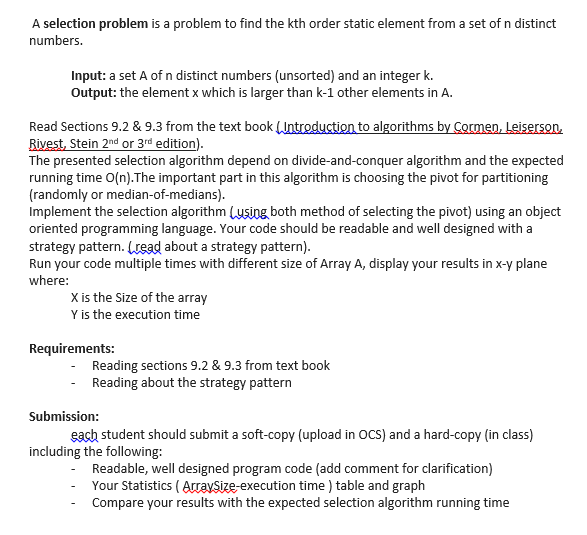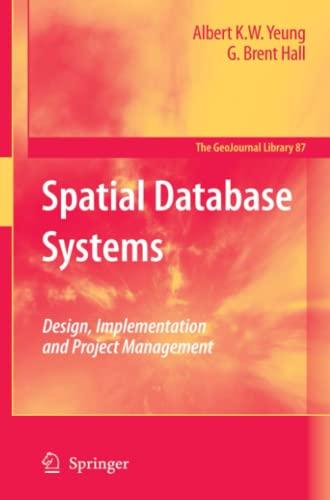Question
This is the code i need the table and graph if the array size is 1 then 2 then 3 then 4 the 5 -

This is the code i need the table and graph if the array size is 1 then 2 then 3 then 4 the 5
- Your Statistics ( ArraySize-execution time ) table and graph
- Compare your results with the expected selection algorithm running time
import java.util.HashSet;
import java.util.Scanner;
public class Median
{
//BSelect by Blum, Floyd, Pratt, Rivest, Tarjon (1972)
//@Author Kishore Ravindran
//@Date of Creating 21-Feb-2011
//Algorithm: DeterministicSelect
//Step 1: Break n elements into blocks of 5 each.
//Step 2: Compute the median of each 5-element block in constant time.
//Step 3: Collect together the n/5 medians and recursively compute their median.
//Step 4: Chose the resulting element as a pivot
public static void main (String[] args)
{
System.out.println("Please enter the size of the array");
Scanner myscan = new Scanner(System.in);
// Handle InputMismatchException exception here;
int number = myscan.nextInt();
Integer [] input = new Integer[number];
System.out.println("Please enter the array elements");
System.out.println("");
for(int i=0;i { input[i] = myscan.nextInt(); } System.out.println("Enter a number less than the size of the array"); System.out.println(""); // Check and InputMismatchException exception needs to be handled here; number = myscan.nextInt(); Median m = new Median(); System.out.println("The " + number + "th smallest element in the input is " + m.DeterministicSelect(input, number)); } // simple module to find the median of a array int median(Integer[] array) { if (array.length == 1) { return array[0]; } int smallerCount = 0; for (int i = 0 ; i { for (int j = 0 ; j { if (array[i] { smallerCount++; } } if (smallerCount == (array.length - 1)/2) { return array[i]; } smallerCount = 0; } return -1; //should never happen } // finds pivot element of a given array recursively using DeterministicSelect int Pivot(Integer[] array) { if (array.length == 1) { return array[0]; } //Divide A into n/5 groups of 5 elements each int numGroups = array.length / 5; if (array.length % 5 > 0) { numGroups++; } Integer[] setOfMedians = new Integer[numGroups]; for (int i = 0 ; i { Integer[] subset; if(array.length % 5 > 0) { if (i == numGroups - 1) { subset = new Integer[array.length % 5]; } else { subset = new Integer[5]; } } else { subset = new Integer[5]; } for (int j = 0; j { subset[j] = array[5*i+j]; } //Find the median of each group setOfMedians[i] = median(subset); } //Use DeterministicSelect to find the median, p, of the n/5 medians int goodPivot = DeterministicSelect(setOfMedians, setOfMedians.length/2 ); return goodPivot; } //The algorithm in words: //1. Divide n elements into groups of 5 //2. Find median of each group (How? How long?) //3. Use Select() recursively to find median x of the n/5? medians //4. Partition the n elements around x. Let k = rank(x) //5. if (i == k) then return x else (i > k) use Select() recursively to find (i-k)th //smallest element in last partition //source //Lecture PDF mentioned in the blog post //and MIT Lecture 6 order statistics. int DeterministicSelect(Integer[] array, int k) { if (array.length == 1) { return array[0]; } int pivot = Pivot(array); //set is used to ignore duplicate values HashSet HashSet for (int i = 0; i { if (array[i] { A1.add(array[i]); } else if (array[i] > pivot) { A2.add(array[i]); } } if (A1.size() >= k) { return DeterministicSelect(A1.toArray(new Integer[0]) ,k); } else if (A1.size() == k-1) { return pivot; } else { return DeterministicSelect(A2.toArray(new Integer[0]) , k - A1.size() - 1); } } }
Step by Step Solution
There are 3 Steps involved in it
Step: 1

Get Instant Access to Expert-Tailored Solutions
See step-by-step solutions with expert insights and AI powered tools for academic success
Step: 2

Step: 3

Ace Your Homework with AI
Get the answers you need in no time with our AI-driven, step-by-step assistance
Get Started


